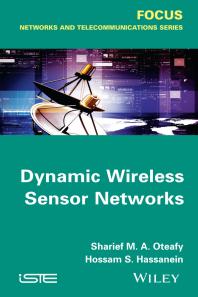书目详情:
CoverTitle PageCopyrightContentsPrefaceList of AcronymsList of NotationsChapter 1: Evolution of Wireless Sensor Networks1.1. The progression of wireless sensor networks1.2. Remote sensing: in retrospect1.3. Inherited designs and protocols from MANets1.4. Book outline1.5. Summary1.6. BibliographyChapter 2: Shifting to Dynamic WSN Paradigms2.1. The hurdle of static operation2.2. Versatile operating systems2.3. Dynamic reprogramming2.4. The rise of service-oriented WSNs2.5. Crowd sensing2.6. BibliographyChapter 3: Resilience and Post-Deployment Maintenance3.1. Impact of harsh environments on network design3.2. High failure proneness of nodes and communication)3.2.1. Detection3.2.2. Classification3.2.3. Location and zoning3.2.4. Isolation3.2.5. Maintenance3.3. Post-deployment maintenance3.4. Re-deployment3.5. Self-re-distributing SNs and mobility3.5.1. Sink mobility3.5.2. Node mobility3.6. BibliographyChapter 4: Current Hindrances in WSNs4.1. Lack of consensus4.2. Resource underutilization in the black-box paradigm4.3. Redundant deployments4.4. Single-application paradigm4.5. Redundancy to boost resilience4.6. IPv6 and enabling internet connectivity4.7. BibliographyChapter 5: Cloud-Centric WSNs5.1. Introduction5.2. The evolution of cloud-centric architectures5.2.1. The cloud variants5.2.2. LowPAN and stub nets5.3. SOA and SODA5.4. Hindrances in adopting cloud-centric WSNs5.4.1. Spatial limitations5.4.2. Temporal limitations5.4.3. Data representation SLAs5.4.4. Impact on resilience5.4.5. Energy efficiency at steak5.4.6. Functional decomposition discrepancies/redesign5.4.7. Breaching anonymity5.4.8. Traffic bottlenecks and query diffusion5.5. Future directions5.6. BibliographyChapter 6: The Resource-Reuse WSN Paradigm6.1. Contributions of the RR-WSN paradigm6.1.1. Revamping the view of WSNs)6.1.2. WSN resource reutilization6.1.3. Multi-application overlay6.1.4. Utilizing non-WSN abundant resources6.1.5. Enabling large-scale deployment6.1.6. Synergy for realizing the Internet of things6.2. RR-WSN: system model6.2.1. Network design6.2.2. Resource attributes6.2.2.1. Functional capability6.2.2.2. Levels of operation6.2.2.3. Power consumption6.2.2.4. Location6.2.2.5. Duty cycling6.2.2.6. Region of fidelity6.2.3. Representing applications6.3. BibliographyChapter 7: Component-Based WSNs: A Resilient Architecture7.1. Component-based DWSN architecture7.1.1. Network model7.1.2. Dynamic core nodes DCN)7.1.3. Wireless dynamic components WDC)7.1.4. Remote wake-up7.2. WDSN in operation: the synergy of dynamic sensing7.2.1. Operation of DWSN7.2.2. DCN in operation7.2.3. WDC in operation7.3. Resilience model7.4. BibliographyChapter 8: Dynamic WSNs – Utilizing Ubiquitous Resources8.1. System model and assumptions8.2. Optimal mapping8.3. BIP formulation8.4. Novel performance evaluation metrics8.4.1. BILP solution using MATLAB LP toolbox: bintprog8.4.2. Amortized functional energy impact8.5. A note on tractability8.6. BibliographyChapter 9: Realizing a Synergetic WSN Architecture for All Resources9.1. Introduction9.2. Motivation and background9.3. System model – arbitrators for WSNs with transient resources9.4. Resource attributes9.5. Transient resources – a special case9.5.1. Spatial properties9.5.2. Temporal properties9.6. Mobility models9.7. Usage cost9.7.1. Asymptotic sigmoidal growth – utilizing the Gompertz function9.7.2. Elastic pricing – impact of scarcity on price9.8. On maximal matching and construed equality between resource providers9.8.1. System model9.8.2. Dynamic rounds – capturing transient resources9.8.3. Utilizing the Hungarian method9.9. BibliographyChapter 10: Future Directions in Sensor Networks10.1. Why applications should not be the sole drive10.2. Ode to formal design over mere analysis10.3. The call for synergy10.4. The rise of biosensors, nano-networks and intelligent prostheses10.5. BibliographyIndex
评论:








